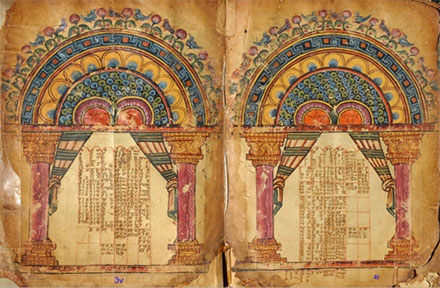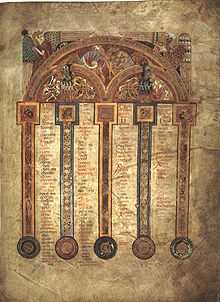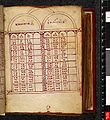
British Library, Royal MS 1. B. VII, also called the Royal Athelstan Gospels, is an 8th-century Anglo-Saxon illuminated gospel book. It is closely related to the Lindisfarne Gospels, being either copied from it or from a common model. It is not as lavishly illuminated, and the decoration shows Merovingian influence. The manuscript contains the four Gospels in the Latin Vulgate translation, along with prefatory and explanatory matter. It was presented to Christ Church, Canterbury in the 920s by King Athelstan, who had recorded in a note in Old English (f.15v) that upon his accession to the throne in 925 he had freed one Eadelm and his family from slavery, the earliest recorded manumission in (post-Roman) England.

Ammonius of Alexandria is assumed to be a Christian philosopher who lived in the 3rd century. He is possibly Ammonius Saccas, the Neoplatonist philosopher, also from Alexandria.

A gospel harmony is an attempt to compile the canonical gospels of the Christian New Testament into a single account. This may take the form either of a single, merged narrative, or a tabular format with one column for each gospel, technically known as a synopsis, although the word harmony is often used for both.

Codex Tischendorfianus IV – designated by Γ or 036, ε 70 – is a Greek uncial manuscript of the Gospels, dated palaeographically to the 10th century. The manuscript is lacunose.
Minuscule 14, ε 1021 is a Greek minuscule manuscript of the New Testament, on 392 parchment leaves, dated by a colophon to the year 964 CE.

Minuscule 2444, is a Greek minuscule manuscript of the New Testament, on 309 paper leaves. It is dated paleographically to the 13th century. Some leaves of the codex were lost.
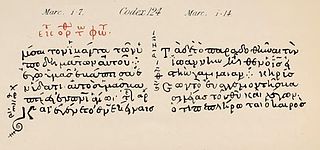
Minuscule 124, ε 1211, is a Greek minuscule manuscript of the New Testament, written on parchment. Using the study of comparative writings styles (palaeography), it has been assigned to the 11th century. It has marginalia and liturgical matter.
The Epistula ad Carpianum or Letter of Eusebius is the title traditionally given to a letter from Eusebius of Caesarea to a Christian named Carpianus. In this letter, Eusebius explains his ingenious system of gospel harmony, the Eusebian Canons (tables) that divide the four canonical gospels, and describes their purpose, ten in number.
Minuscule 475, α 138, is a Greek minuscule manuscript of the New Testament, on parchment. Palaeographically it has been assigned to the 11th century. Scrivener labelled it number 515. It has full marginalia.
Minuscule 511, ε 342, is a Greek minuscule manuscript of the New Testament, on paper. Palaeographically it has been assigned to the 13th century. Scrivener labelled it by number 497. The manuscript is lacunose, marginalia are complete. It was adapted for liturgical use.

Minuscule 532, ε 255, is a Greek minuscule manuscript of the New Testament, on parchment. Palaeographically it has been assigned to the 12th century. Scrivener labeled it number 545. The manuscript was adapted for liturgical use. It is very incomplete, with many omissions and faded text along with much of it being missing because a missing manuscript contains some of the text.
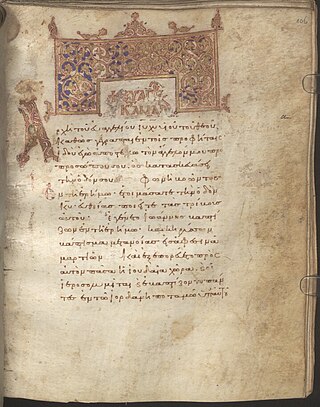
Minuscule 652, ε1095, is a Greek minuscule manuscript of the New Testament, written on parchment. Using the study of comparative writing styles (palaeography), it has been assigned to the 10th century. The manuscript has complex contents. Biblical scholar Frederick H. A. Scrivener labelled it as 875.
Minuscule 661, ε 179, is a Greek language minuscule manuscript of the New Testament, on parchment. Palaeographically it has been assigned to the 11th century. The manuscript has complex contents. Scrivener labelled it by 639e.
Minuscule 657, ε 180, is a Greek minuscule manuscript of the New Testament, on parchment. Palaeographically it has been assigned to the 11th or 12th century. The manuscript is lacunose. Scrivener labelled it by 876e.
Minuscule 708, ε153, is a Greek minuscule manuscript of the New Testament, on parchment. Palaeographically it has been assigned to the 11th century. The manuscript is lacunose. Scrivener labelled it as 607e.
Minuscule 773 (in the Gregory-Aland numbering), A14 (von Soden), is a Greek minuscule manuscript of the New Testament written on parchment. Palaeographically it has been assigned to the 10th century. The manuscript has no complex contents. Scrivener labelled it as 868e.

Minuscule 788, ε1033, is a Greek minuscule manuscript of the New Testament written on parchment. Using the study of comparative handwriting styles (palaeography), it has been assigned to the 11th century.
Minuscule 804, ε614, is a Greek minuscule manuscript of the New Testament written on parchment. Palaeographically it has been assigned to the 11th century. The manuscript is lacunose.
Minuscule 899 is a Greek minuscule manuscript of the New Testament, on parchment. Palaeographically it has been assigned to the 11th century.
Minuscule 924, ε 1355, is a 13th-century Greek minuscule manuscript of the New Testament on parchment. It has marginalia. The manuscript has survived in complete condition.
